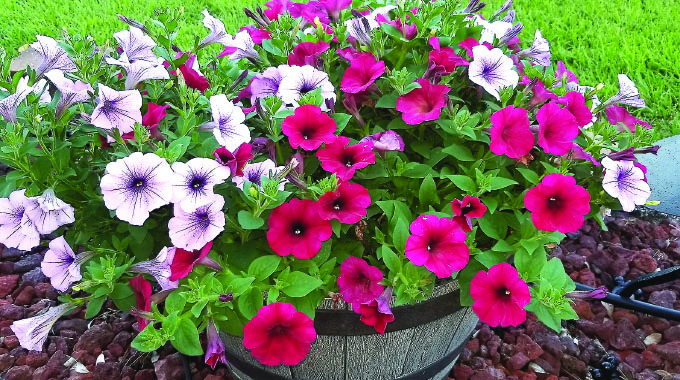Taking care of Petunias this season

Home and Garden Writer
For many centuries flowers occupied an important place in our lives.
Flowers are regarded as a symbol of love, beauty and a gift of nature.
They are used by people to provoke the feelings of love and happiness because they have the power to make people happy and cheerful.
On different occasions people make use of different kinds of flowers.
Apart from expressing feelings and emotions, studies have also shown that flowers are capable of influencing our moods. Beautiful flowers kept in hospital rooms can reduce the stress of patients and improve their recovery. It has also been seen a vase filled with fresh flowers in the drawing room, dining room and living room creates a relaxing atmosphere and enhances the beauty of home.
However this season, the most trendiest flowers to go by are the petunias, almost found at every homestead.
Petunias are one of the most popular garden flowers and they bloom throughout the summer, except in extreme heat.
One can find petunias in just about every colour but true blue and with growing habits that mound in borders or trail down containers.
According to The Spruce, petunias are one of the most popular garden flowers for both borders and containers.
“They are prolific bloomers, although some forms require deadheading to keep them going. Petunias have wide trumpet-shaped flowers and branching foliage that is hairy and somewhat sticky.
Within the petunia family, there is great variety: single and double blooms, ruffled or smooth petals, striped, veined or solid colors, mounding and cascading habits and even some with fragrance.
Most of the petunias sold today are hybrids, developed for specific design purposes. They grow easily when you transplant them to the garden, and this should be done in the spring when the threat of frost has passed,” writes florist expert Marie Iannotti.
Although some species of petunias are tropical perennials, today’s hybrids are usually grown as annuals, so hardiness zones are not a factor in growing them.
They like cool weather and they are not cold-tolerant.
“You just have to wait until all danger of cold is past before planting your petunias outdoors.
Petunias repeat bloom throughout the summer. Some varieties will require frequent dead-heading and some stem pruning to continue setting flower buds.
Extreme heat can cause petunia plants to stop setting flowers until the temperature drops.
Older varieties of petunias require diligent dead-heading or they will stop blooming.
This is not always a pleasant task since the foliage is sticky and blossoms that have been rained on will turn into slimy mush.
Even the newer varieties that say they don’t require dead-heading will benefit from a pinching or shearing mid-season.
“When the branches start to get long and you can see where all the previous flowers were along the stem, it’s time to cut them back and refresh the plant,” she explained.
However monthly feeding or foliage feeding will give your petunias the energy they need to stay in bloom.
But be judicious with water and make sure the soil is well drained.
Too much water will cause the plants to become “leggy”, with lots of stem and few flowers.
Here are factors to consider when planting one be in vase or in garden:
Light
Most petunia varieties prefer full sun, but in the heat of summer, partial shade will keep them refreshed and blooming better.
Soil Petunias require a light, fertile soil that provides good drainage. They like a slightly acidic soil pH.
Water
Like many flowering annuals, petunias don’t like to be dry for long periods. But they also don’t like wet feet. Weekly, deep watering is sufficient—except for spreading and container-grown petunias, which may require daily watering.
Temperature and Humidity
Petunias also prefer warmer temperatures for germination. Start the seeds on heating pads or on top of your refrigerator. Once the seed has germinated, move them from the warm area and let them grow on in cooler temperatures.
Fertiliser
Garden petunias like a balanced fertilizer such as 8-8-8, 10-10-10, or 12-12-12. In early to mid-July, start using a liquid fertiliser every two to three weeks.
Spreading petunias may need weekly fertilisation, while container-grown plants will respond well to a time-release fertiliser. — thesprucesource









Comments